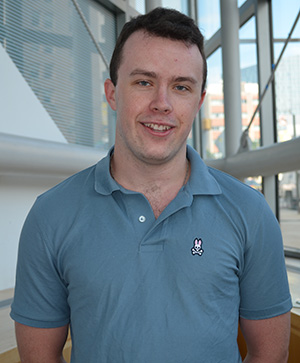By Lini S. Kadaba
 Imagine Iron Man’s strong suit of armor. That’s what Vladislavis Sautkulis ’19 is working to create, minus the weapons and flight capabilities, of course.
Imagine Iron Man’s strong suit of armor. That’s what Vladislavis Sautkulis ’19 is working to create, minus the weapons and flight capabilities, of course.
“I thought it would be fun to build one,” says the 21-year-old from Norwalk, Conn. “I’m a huge nerd.” For the record, that was back in high school. Now, Sautkulis is studying electrical engineering technology and closer than ever to realizing his ambition of surpassing human limits, Iron Man style.
Known as Human Augmentation, the research project seeks to create a soft exoskeleton suit that can increase strength of limbs or restore motor abilities to those without function. Sautkulis, studying electrical engineering technology and the project leader, is working on the idea with Jacob Lockspeiser ’20, Braedon Jelinek ’19, Alexis Hanford ’19 and Conor Seery ’19 along with advisers Lunal Khuo, an associate clinical professor of engineering technology director of research, and Yalcin Ertekin, an associate professor of engineering technology.
Surface electrodes sensing myoelectric signals (electrical impulses that cause muscle fibers in the body to contract) would allow the exosuit, made of a comfortable, form-fitting and flexible fabric, to anticipate the user’s movement and supplement it by way of soft artificial muscles that use pneumatic pumps to operate, Sautkulis says. In other words, think the movement, and the suit will do the work. Ideally, the augmented muscles would “move as fluidly as your thoughts,” he adds.
That’s the concept, at least. Sautkulis, who has used his own money from co-ops and “stuff found around the machine lab,” is busy testing the artificial muscle and the sensory equipment, he says. He estimates that producing a prototype would run about $2,000 and welcomes any funders. Sautkulis says the two pieces—the muscle and sensors—work. “We still have to combine them,” he says. “That’s the tricky part.”
Sautkulis envisions the suit having uses in the military, especially augmenting leg strength. Soldiers “have to carry tremendously large rucksacks, which cause back problems,” he says.
Sautkulis also sees applications in industry and within medicine. “I intend to make a company of this,” he says. Plan B: He plans to get a job with a Lockheed Martin or Boeing.
“I want to build a new form of technology that I like and helps the world,” he says.